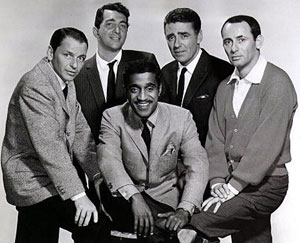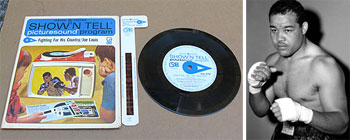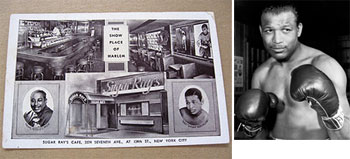I keep bumping into Frank Sinatra through my auctions finds. His name has turned up several times as I researched a person or an object rooted in African American history.

Sure, I was familiar with Sinatra’s long friendship with Sammy Davis Jr., and how he opened up the Rat Pack to the entertainer. The cynic in me always wondered if Davis was the Pack’s pet or truly a member of equal standing. It seemed that he was truly. In their Las Vegas, I’m sure that Sinatra was also this black man’s protector (one former pit boss at the Sands Hotel & Casino noted that it was tough for Davis when The Chairman was out of town).
The first time I bumped into Sinatra was after I found a milk crate with 70 records, one of which was a 1956 recording called “Laff of the Party” by comedian Redd Foxx. It was a 45, still in its original cardboard sleeve with a comic drawing of Foxx on the front. I was drawn to it by both the artist and one particular song: “Women Over 40.” Since We Are Black Women caters to that group, I wanted to know what Foxx had to say about us.

The record was produced by Dooto Records, with which Foxx had a 15-year contract that he tried to cancel early. He accused the owner of holding out on royalties. In stepped Sinatra, who bought out Foxx’s contract and signed him to his Loma Records. According to a 1967 article in Ebony magazine, Foxx’s first recording with the label sold 15,000 copies in 30 days. The article also said that Sinatra signed him right after seeing him perform in a Los Angeles nightclub.
Foxx’s first album with Loma was said to be “The Both Sides of Redd Foxx,” recorded in a nightclub in Hollywood.
When IRS agents stripped the comedian’s Las Vegas home in 1990 to pay off his tax debts, one of the items removed was a picture of Sinatra. Here’s a video of Foxx during a Dean Martin Celebrity Roast of Sinatra in 1977. It is so funny.

Sinatra’s name came up again when I was researching a child’s Show ‘N Tell record of Joe Louis’ 1942 charity fight with Abe Simon. This time, he was helping the boxing champ out of a financial mudhole. Louis blew all of his money, owed the IRS and left the ring broke.
A fan and friend, Sinatra came to his rescue when hard times hit the former boxer, which seemed to be pretty often. Sinatra paid his medical bills (including the doctor who performed heart surgery in 1977), supported him financially later in life and paid for his funeral.
Sinatra must have been an avid boxing fan because he also offered a hand to Sugar Ray Robinson – which I found out about through a postcard from the boxer’s café “Sugar Ray” in Harlem. He opened the restaurant in 1946, soon after winning the welterweight title. He, too, ran into some difficulties with the IRS and admitted to blowing most of his money.

The club attracted people like Sinatra, Eartha Kitt, Leona Horne, Jackie Gleason and Elizabeth Taylor. Sinatra got Robinson a role as a police officer in his 1969 movie “The Detective” after Robinson left the ring and needed money.
Sinatra’s influence was apparently a lot wider: He crusaded for civil rights during the 1950s and 1960s. He worked with Dr. Martin Luther King Jr. and opened casino doors to black entertainers in Las Vegas. He refused to perform in hotels where black entertainers were not admitted. He helped desegregate the Sands (in a campaign spearheaded by a black physician named James McMillan, among others) and other Las Vegas hotels. He hired black architect Paul Williams to build his home in Hollywood. He made a short movie for children titled “The House I Live In” aimed at combatting bigotry.
In July 1958, he wrote an article in Ebony on racism in America and took a stand against it. When he died in 1998, Ebony chronicled his civil-rights contributions in an article titled “Blacks Mourn Death of a Frank Sinatra Nobody Knew.”
I knew Sinatra the singer and the actor. But the activist? This was a Sinatra I did not know. Pleased to meet you, Frank.

It is a little known fact that FS was a champion of cvil rights, decades before it became a major focal point in the US. The article in the July 58 edition of Ebony is a classic of its’ kind. FS was unusually accurate in many parts of the article, notably regarding the ending of segregation in his lifetime. He would have expressed no surprise in the possibility of a African American US president, he was so far ahead of the curve.
There is very rare footage of FS and Count Basie performing to an entirely black audience at San Quentin Prison in 1965, four years before Johnny Cash’s celebrated show. He also formed anti-lynching pressure groups with Eleanor Roosevelt as early as 1946. There are countless examples of his anti-racist stance which didn’t endear him to the more conservative elements of America, notably Gerald K. Smith and others.
The KKK burnt effigies of him in the Deep South when he was best man at Sammy Davis Jr’s marriage. He also arranged for Nat Cole to be flown out of Alabama, when he was attacked onstage by a group of racist thugs. Sinatra was also the pallbearer at his funeral when Nat died in 1965. He never went to funerals, so it spoke volumes that he wanted to carry his friend’s coffin.
Sinatra once once said, “If you see your brother on his knees, why not give him a helping hand?” He was a class act.